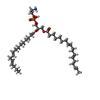[English] 日本語
 Yorodumi
Yorodumi- PDB-4dor: Human Nuclear Receptor Liver Receptor Homologue-1, LRH-1, in its ... -
+ Open data
Open data
- Basic information
Basic information
| Entry | Database: PDB / ID: 4dor | ||||||
|---|---|---|---|---|---|---|---|
| Title | Human Nuclear Receptor Liver Receptor Homologue-1, LRH-1, in its apo State Bound to a Fragment of Human SHP Box1 | ||||||
 Components Components |
| ||||||
 Keywords Keywords |  TRANSCRIPTION / TRANSCRIPTION /  nuclear receptor / nuclear receptor /  ligand binding domain / ligand binding domain /  phospholipids / NR5A / phospholipids / NR5A /  Diabetes / Diabetes /  phosphatidylcholine phosphatidylcholine | ||||||
| Function / homology |  Function and homology information Function and homology information Regulation of gene expression in early pancreatic precursor cells / pancreas morphogenesis / calcineurin-mediated signaling / acinar cell differentiation / tissue development / bile acid metabolic process / bile acid and bile salt transport / transcription regulator inhibitor activity / peroxisome proliferator activated receptor binding / embryo development ending in birth or egg hatching ... Regulation of gene expression in early pancreatic precursor cells / pancreas morphogenesis / calcineurin-mediated signaling / acinar cell differentiation / tissue development / bile acid metabolic process / bile acid and bile salt transport / transcription regulator inhibitor activity / peroxisome proliferator activated receptor binding / embryo development ending in birth or egg hatching ... Regulation of gene expression in early pancreatic precursor cells / pancreas morphogenesis / calcineurin-mediated signaling / acinar cell differentiation / tissue development / bile acid metabolic process / bile acid and bile salt transport / transcription regulator inhibitor activity / peroxisome proliferator activated receptor binding / embryo development ending in birth or egg hatching / nuclear thyroid hormone receptor binding / homeostatic process / positive regulation of viral genome replication / animal organ regeneration / response to glucose / nuclear retinoid X receptor binding / Regulation of gene expression in early pancreatic precursor cells / pancreas morphogenesis / calcineurin-mediated signaling / acinar cell differentiation / tissue development / bile acid metabolic process / bile acid and bile salt transport / transcription regulator inhibitor activity / peroxisome proliferator activated receptor binding / embryo development ending in birth or egg hatching / nuclear thyroid hormone receptor binding / homeostatic process / positive regulation of viral genome replication / animal organ regeneration / response to glucose / nuclear retinoid X receptor binding /  Notch signaling pathway / cholesterol metabolic process / cellular response to leukemia inhibitory factor / hormone-mediated signaling pathway / cholesterol homeostasis / Notch signaling pathway / cholesterol metabolic process / cellular response to leukemia inhibitory factor / hormone-mediated signaling pathway / cholesterol homeostasis /  transcription coregulator binding / transcription coregulator binding /  phospholipid binding / circadian regulation of gene expression / SUMOylation of intracellular receptors / negative regulation of DNA-binding transcription factor activity / positive regulation of insulin secretion / response to organic cyclic compound / Nuclear Receptor transcription pathway / phospholipid binding / circadian regulation of gene expression / SUMOylation of intracellular receptors / negative regulation of DNA-binding transcription factor activity / positive regulation of insulin secretion / response to organic cyclic compound / Nuclear Receptor transcription pathway /  circadian rhythm / RNA polymerase II transcription regulator complex / transcription corepressor activity / circadian rhythm / RNA polymerase II transcription regulator complex / transcription corepressor activity /  nuclear receptor activity / sequence-specific double-stranded DNA binding / regulation of cell population proliferation / DNA-binding transcription activator activity, RNA polymerase II-specific / response to ethanol / Estrogen-dependent gene expression / sequence-specific DNA binding / transcription cis-regulatory region binding / DNA-binding transcription factor activity, RNA polymerase II-specific / RNA polymerase II cis-regulatory region sequence-specific DNA binding / DNA-binding transcription factor activity / protein domain specific binding / negative regulation of gene expression / intracellular membrane-bounded organelle / negative regulation of DNA-templated transcription / nuclear receptor activity / sequence-specific double-stranded DNA binding / regulation of cell population proliferation / DNA-binding transcription activator activity, RNA polymerase II-specific / response to ethanol / Estrogen-dependent gene expression / sequence-specific DNA binding / transcription cis-regulatory region binding / DNA-binding transcription factor activity, RNA polymerase II-specific / RNA polymerase II cis-regulatory region sequence-specific DNA binding / DNA-binding transcription factor activity / protein domain specific binding / negative regulation of gene expression / intracellular membrane-bounded organelle / negative regulation of DNA-templated transcription /  chromatin binding / chromatin binding /  chromatin / protein-containing complex binding / positive regulation of gene expression / regulation of DNA-templated transcription / regulation of transcription by RNA polymerase II / positive regulation of DNA-templated transcription / negative regulation of transcription by RNA polymerase II / protein homodimerization activity / positive regulation of transcription by RNA polymerase II / chromatin / protein-containing complex binding / positive regulation of gene expression / regulation of DNA-templated transcription / regulation of transcription by RNA polymerase II / positive regulation of DNA-templated transcription / negative regulation of transcription by RNA polymerase II / protein homodimerization activity / positive regulation of transcription by RNA polymerase II /  DNA binding / zinc ion binding / DNA binding / zinc ion binding /  nucleoplasm / nucleoplasm /  nucleus / nucleus /  cytoplasm cytoplasmSimilarity search - Function | ||||||
| Biological species |   Homo sapiens (human) Homo sapiens (human) | ||||||
| Method |  X-RAY DIFFRACTION / X-RAY DIFFRACTION /  SYNCHROTRON / SYNCHROTRON /  MOLECULAR REPLACEMENT / Resolution: 1.9 Å MOLECULAR REPLACEMENT / Resolution: 1.9 Å | ||||||
 Authors Authors | Musille, P.M. / Ortlund, E.A. | ||||||
 Citation Citation |  Journal: Nat.Struct.Mol.Biol. / Year: 2012 Journal: Nat.Struct.Mol.Biol. / Year: 2012Title: Antidiabetic phospholipid-nuclear receptor complex reveals the mechanism for phospholipid-driven gene regulation. Authors: Musille, P.M. / Pathak, M.C. / Lauer, J.L. / Hudson, W.H. / Griffin, P.R. / Ortlund, E.A. | ||||||
| History |
|
- Structure visualization
Structure visualization
| Structure viewer | Molecule:  Molmil Molmil Jmol/JSmol Jmol/JSmol |
|---|
- Downloads & links
Downloads & links
- Download
Download
| PDBx/mmCIF format |  4dor.cif.gz 4dor.cif.gz | 112.7 KB | Display |  PDBx/mmCIF format PDBx/mmCIF format |
|---|---|---|---|---|
| PDB format |  pdb4dor.ent.gz pdb4dor.ent.gz | 86.8 KB | Display |  PDB format PDB format |
| PDBx/mmJSON format |  4dor.json.gz 4dor.json.gz | Tree view |  PDBx/mmJSON format PDBx/mmJSON format | |
| Others |  Other downloads Other downloads |
-Validation report
| Arichive directory |  https://data.pdbj.org/pub/pdb/validation_reports/do/4dor https://data.pdbj.org/pub/pdb/validation_reports/do/4dor ftp://data.pdbj.org/pub/pdb/validation_reports/do/4dor ftp://data.pdbj.org/pub/pdb/validation_reports/do/4dor | HTTPS FTP |
|---|
-Related structure data
- Links
Links
- Assembly
Assembly
| Deposited unit | 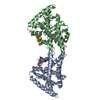
| ||||||||
|---|---|---|---|---|---|---|---|---|---|
| 1 |
| ||||||||
| 2 | 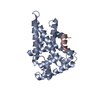
| ||||||||
| 3 | 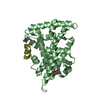
| ||||||||
| Unit cell |
|
- Components
Components
| #1: Protein | Mass: 29459.893 Da / Num. of mol.: 2 / Fragment: UNP residues 290-541 Source method: isolated from a genetically manipulated source Source: (gene. exp.)   Homo sapiens (human) / Gene: B1F, CPF, FTF, LRH-1, NR5A2 / Plasmid: pLIC_MBP / Production host: Homo sapiens (human) / Gene: B1F, CPF, FTF, LRH-1, NR5A2 / Plasmid: pLIC_MBP / Production host:   Escherichia coli (E. coli) / Strain (production host): BL21(DE3) / References: UniProt: O00482 Escherichia coli (E. coli) / Strain (production host): BL21(DE3) / References: UniProt: O00482#2: Protein/peptide | Mass: 1449.673 Da / Num. of mol.: 2 / Fragment: UNP residues 15-28 / Source method: obtained synthetically / Source: (synth.)   Homo sapiens (human) / References: UniProt: Q15466 Homo sapiens (human) / References: UniProt: Q15466#3: Chemical | ChemComp-EPH / |  Phosphatidylethanolamine Phosphatidylethanolamine#4: Water | ChemComp-HOH / |  Water Water |
|---|
-Experimental details
-Experiment
| Experiment | Method:  X-RAY DIFFRACTION / Number of used crystals: 1 X-RAY DIFFRACTION / Number of used crystals: 1 |
|---|
- Sample preparation
Sample preparation
| Crystal | Density Matthews: 2.23 Å3/Da / Density % sol: 44.86 % |
|---|---|
Crystal grow | Temperature: 298 K / Method: vapor diffusion, hanging drop / pH: 6.4 Details: 9.5%-15% PEG 3350, 5% glycerol, and 50 mM Bis-Tris, pH 6.4, VAPOR DIFFUSION, HANGING DROP, temperature 298K |
-Data collection
| Diffraction | Mean temperature: 100 K |
|---|---|
| Diffraction source | Source:  SYNCHROTRON / Site: SYNCHROTRON / Site:  APS APS  / Beamline: 22-ID / Wavelength: 1 Å / Beamline: 22-ID / Wavelength: 1 Å |
| Detector | Type: MARMOSAIC 300 mm CCD / Detector: CCD / Date: Jan 1, 2010 |
| Radiation | Monochromator: Si 111 CHANNEL / Protocol: SINGLE WAVELENGTH / Monochromatic (M) / Laue (L): M / Scattering type: x-ray |
| Radiation wavelength | Wavelength : 1 Å / Relative weight: 1 : 1 Å / Relative weight: 1 |
| Reflection | Resolution: 1.9→45 Å / Num. all: 42849 / Num. obs: 42806 / % possible obs: 99.9 % / Observed criterion σ(F): 0 / Observed criterion σ(I): 0 / Redundancy: 3.9 % / Net I/σ(I): 13 |
- Processing
Processing
| Software |
| ||||||||||||||||||||||||||||||||||||||||||||||||||||||||||||
|---|---|---|---|---|---|---|---|---|---|---|---|---|---|---|---|---|---|---|---|---|---|---|---|---|---|---|---|---|---|---|---|---|---|---|---|---|---|---|---|---|---|---|---|---|---|---|---|---|---|---|---|---|---|---|---|---|---|---|---|---|---|
| Refinement | Method to determine structure : :  MOLECULAR REPLACEMENT / Resolution: 1.9→27.67 Å / Cor.coef. Fo:Fc: 0.955 / Cor.coef. Fo:Fc free: 0.931 / Occupancy max: 1 / Occupancy min: 0.83 / SU B: 5.731 / SU ML: 0.078 / Cross valid method: THROUGHOUT / σ(F): 0 / ESU R: 0.355 / ESU R Free: 0.135 / Stereochemistry target values: MAXIMUM LIKELIHOOD MOLECULAR REPLACEMENT / Resolution: 1.9→27.67 Å / Cor.coef. Fo:Fc: 0.955 / Cor.coef. Fo:Fc free: 0.931 / Occupancy max: 1 / Occupancy min: 0.83 / SU B: 5.731 / SU ML: 0.078 / Cross valid method: THROUGHOUT / σ(F): 0 / ESU R: 0.355 / ESU R Free: 0.135 / Stereochemistry target values: MAXIMUM LIKELIHOODDetails: HYDROGENS HAVE BEEN USED IF PRESENT IN THE INPUT U VALUES : REFINED INDIVIDUALLY
| ||||||||||||||||||||||||||||||||||||||||||||||||||||||||||||
| Solvent computation | Ion probe radii: 0.8 Å / Shrinkage radii: 0.8 Å / VDW probe radii: 1.2 Å / Solvent model: MASK | ||||||||||||||||||||||||||||||||||||||||||||||||||||||||||||
| Displacement parameters | Biso max: 65.69 Å2 / Biso mean: 24.3912 Å2 / Biso min: 9.84 Å2
| ||||||||||||||||||||||||||||||||||||||||||||||||||||||||||||
| Refinement step | Cycle: LAST / Resolution: 1.9→27.67 Å
| ||||||||||||||||||||||||||||||||||||||||||||||||||||||||||||
| Refine LS restraints |
| ||||||||||||||||||||||||||||||||||||||||||||||||||||||||||||
| LS refinement shell | Resolution: 1.902→1.951 Å / Total num. of bins used: 20
|
 Movie
Movie Controller
Controller


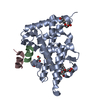
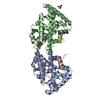
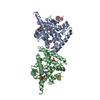


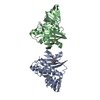
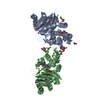
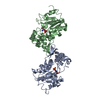
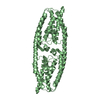
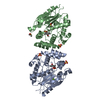

 PDBj
PDBj
